Table of Contents
Last updated on August 18th, 2025 at 10:34 pm
The binge restrict cycle is one of the most common and painful patterns people experience in their relationship with food. It usually begins with strict rules, heavy restriction, or skipping meals in an effort to gain control. But as the body and mind fight back against deprivation, intense cravings and feelings of loss of control around food often follow, leading to episodes of binge eating. Afterward, guilt and shame fuel the urge to restrict again, and the cycle repeats. Over time, this back-and-forth can feel exhausting and impossible to escape, but understanding why it happens is the first step toward breaking free.
You might think that if you have overeaten, the most logical thing to do is to restrict your food at the next meal to avoid unwanted weight gain or “cancel out” and toxic foods you had during your binge. But in reality, this will simply cause a seemingly insatiable obsession with food. This is actually the exact opposite of what you should be doing to prevent future binge eating.
So how can you break the vicious restrict binge cycle?
This article explores the role restriction plays in binging, and the biological reasons behind why the binge restrict cycle happens. We’ll explore to stop the vicious bine restriction cycle and be binge free for life.
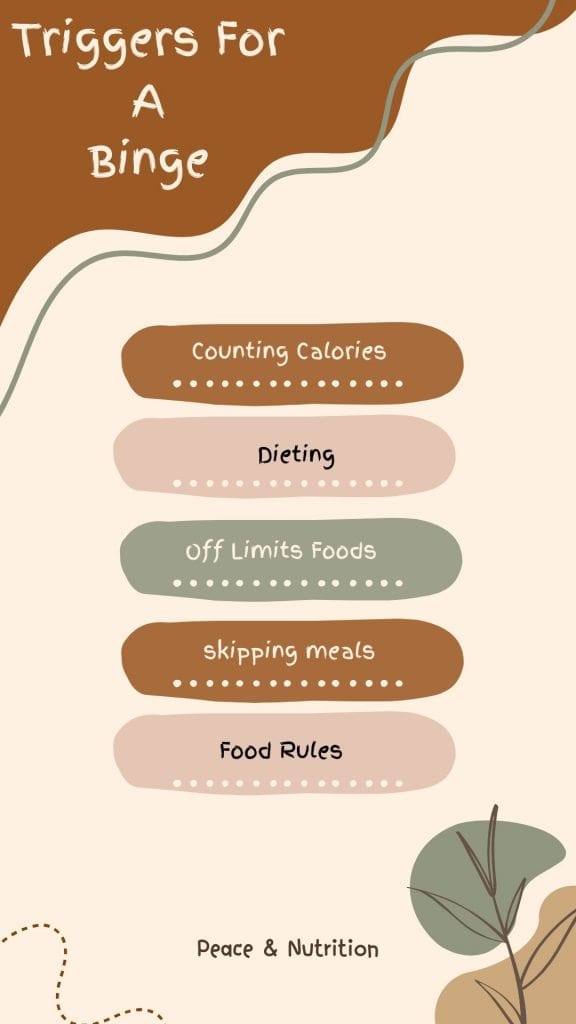
What is The Binge Restrict Cycle
The binge restrict cycle is a pattern of eating where periods of food restriction are followed by episodes of binge eating often leading to feelings of guilt and shame that fuel further food restriction. It’s a cycle that can feel endless and overwhelming because both restriction and bingeing feed into each other.
The 5 Steps of the binge restrict cycle include:
- Eating A LOT of food
- Eating rapidly and feeling out of control while you are eating your binge food
- Intense feelings of shame, guilt or fear following eating
- Hiding your binge food (only eating the food while alone or hiding wrappers in the trash)
- Cutting calories, food groups or entire meals the hours or days after a binge
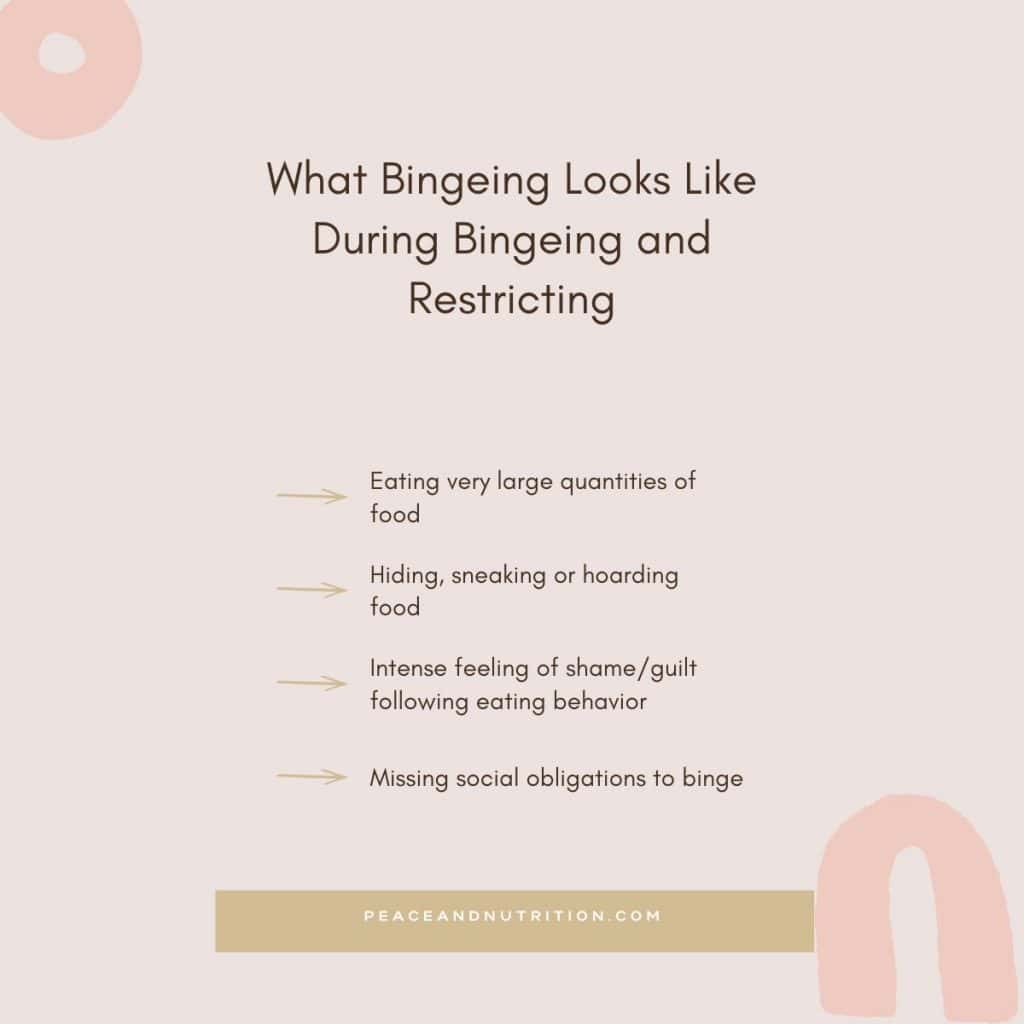
What Triggers The Binge Restrict Cycle
The binge restrict cycle doesn’t happen in isolation. it’s often fueled by triggers that set the cycle in motion. These triggers can be both physical and emotional, and understanding them is a key step toward breaking free.
Triggers for bingeing and restricting include includes:
- Feeling out of control with food
- Having a fear of wasting food because you’re constantly restricting food
- Guilt, shame and sadness when you can’t control what you eat
- Feeling disgusted with your body
- Feeling impulsive, urgent, and worthless when it comes to your food choices
- Cutting out food groups
- Waiting to eat until a certain time despite feeling hungry
- Intermittent fasting
- Missing social events to restrict food
- Counting or restricting your calories
- Scheduling “cheat days” for strict diets
- You Can’t stop thinking about food
- Weighing your food or restricting your portions
Why Bingeing after Restricting Happens
Let’s think back to caveman times. Over thousands of years, humans have experienced bouts of feast and famine.
Binging in historical times was pretty normal. It prepared you for inevitable famines when food was not available. It allowed you to eat enough food to store body fat for use when food was scarce and eat more when food was available.
After you restrict your food here’s what happens:
- Your body reduce the production of leptin (our satiety signals)
- Your body Increase grehlin (your hunger signals)
- Rate of your enzymatic reactions change (to amp up your hunger)
- Cortisol increases which causing you to crave calorie dense foods (and a lot of it)
- Increase in salivation (starting the process of digestion and makes you hungrier)
- Surge of neuropeptide Y (which causes intense cravings for carbohydrates)
- Increased dopamine in the brain while binging (which makes you want to eat more
Salivation increases even if food isn’t present(you’re just thinking about the food) when you have been restricting. This increases your desire to seek out food an eat more of it when its available.
You will have an increase in digestion hormones both before AND after eating when you have restricted your food. To put it simply your body hates when food is not available (intentionally or unintentionally) and it will do everything possible to make sure you get as much food as possible in times of “feast” when it follows a “famine.”
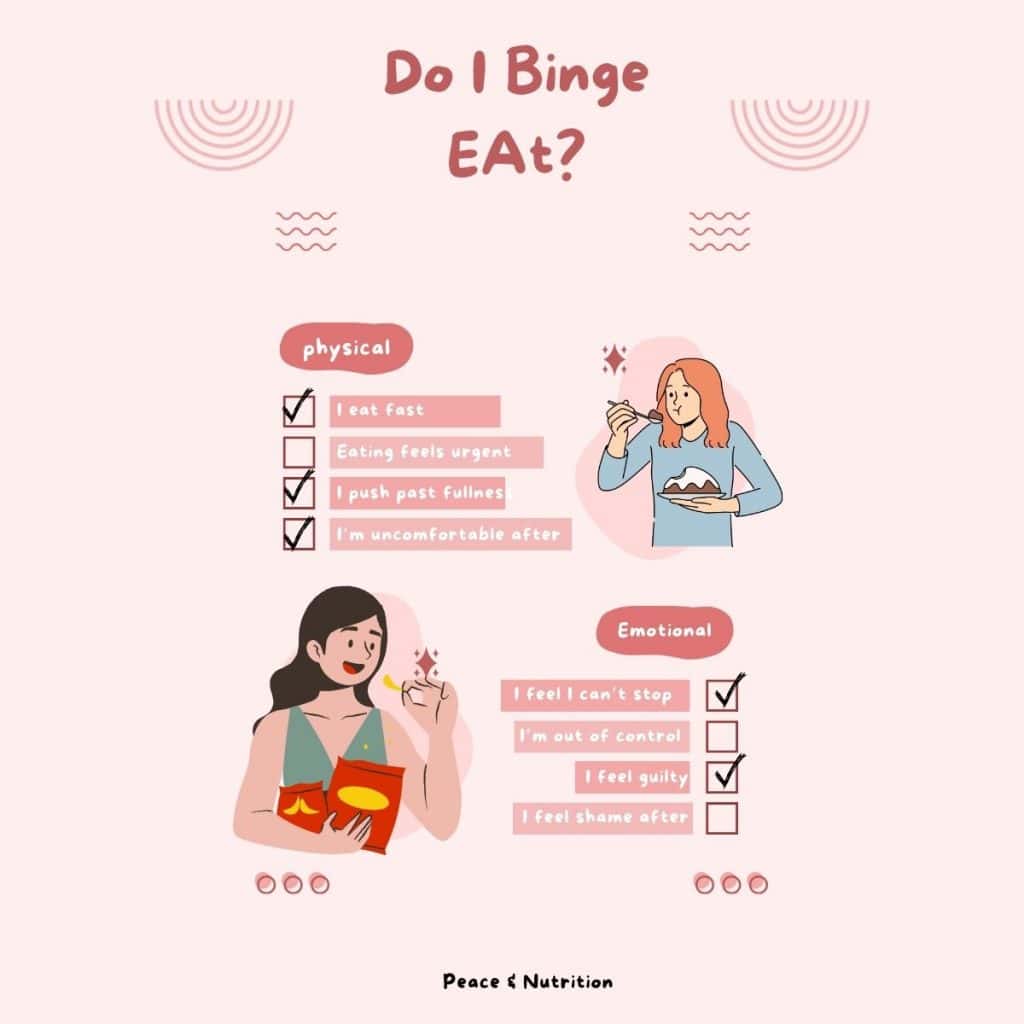
Binge Restrict Cycle In Eating Disorders
If you have an eating disorder your body is in starvation mode. The binge restrict cycle is a core feature in many eating disorders, and it plays a major role in keeping the illness going. At its heart, the cycle is a tug-of-war between food deprivation and loss of control. It typically starts with restriction including skipping meals, counting calories, cutting out entire food groups, or trying to “eat as little as possible.” Eventually, this often leads to a binge, where someone consumes large amounts of food quickly, often feeling out of control while doing so.
During weight restoration from an eating disorder you will probably binge eat at some point. This is a normal and necessary part of eating disorder recovery. This is your bodies way of trying to protect itself. It is very likely that your eating disorder voice is very loud in the experience of binging and is telling you to immediately STOP! However, the more you try to resist these binge episodes the more you will binge and the longer it will take for you to heal your body from starvation.

Binge eating in anorexia recovery can come from
- Hypermetabolism in anorexia
- Microbiome shifts
- Alteration in enzymatic reactions
- Anatomical changes in GI tract
- Hormonal shifts
Binge Purge Restrict Cycle
If you have bulimia nervosa, you might use purging to try to get rid of food you ate during a binge. This makes the binge restrict cycle even more complex, and you will need use strategies to stop purging in addition to breaking the binge restrict cycle.
If you are purging, you may feel cleanliness and even relaxation before, during or after the purge. This can make future purging behavior seem appealing, especially after a binge.
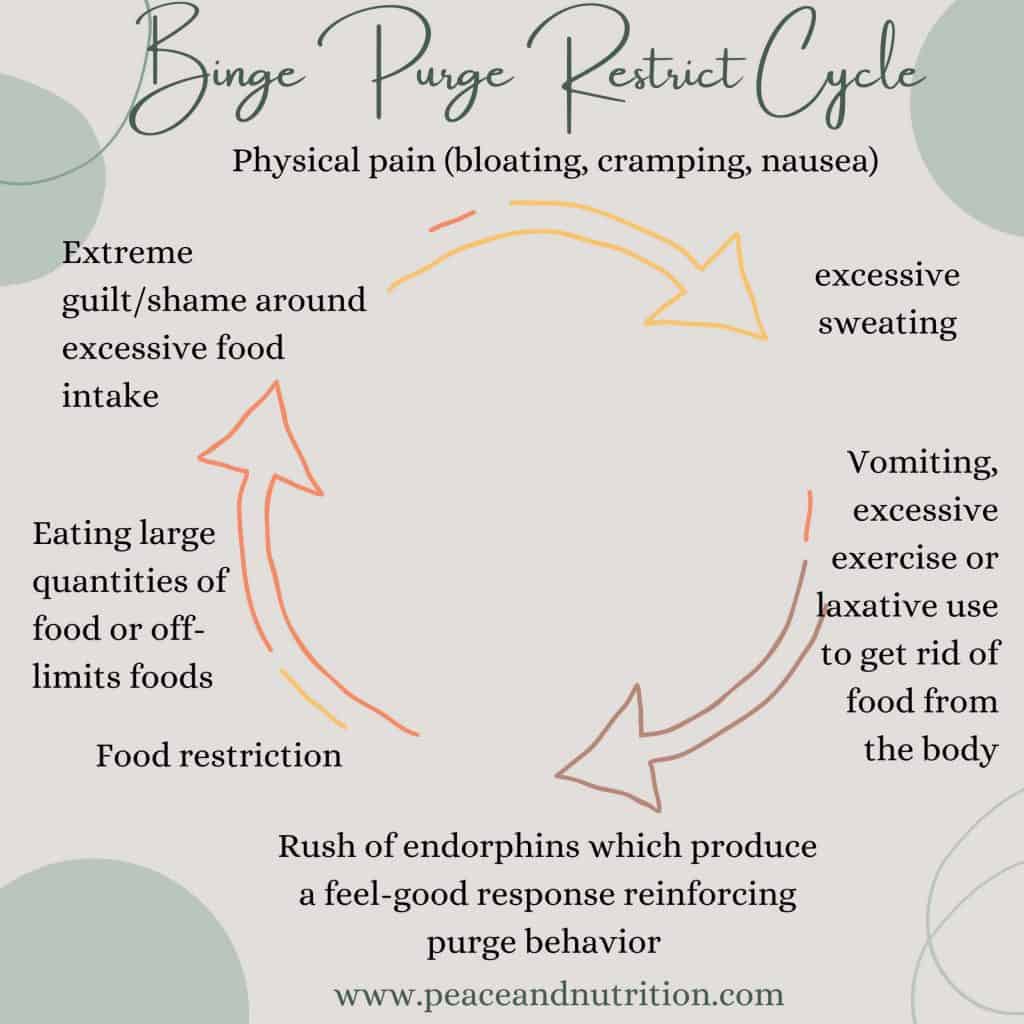
The binge, purge restrict cycle includes:
- Food restriction (mental and/or physical)
- Eating large quantities of food or off-limits foods
- Extreme guilt/shame around excessive food intake
- Physical pain including bloating, cramping, and potentially nausea or diahrrhea
- Excessive sweating
- Vomiting, excessive exercise or laxative use to get rid of food from the body
- Rush of endorphins which produce a feel-good response reinforcing purge behavior
- Food restriction (mental and/or physical)
It is a good idea to talk with your healthcare team about the unique strategies that will be involved in preventing food restriction, reducing binges, and purging cessation. All of these behaviors will likely involve different treatment strategies and your healthcare team may work with you on each to reduce each behavior independently rather than all at once.

19 Tips To Stop Binging And Restricting
To break the binge restrict cycle, you need to create a partnership of trust with your body. You need to trust your body to tell you what it needs and wants to properly nourish itself and it needs to trust you to provide the food.
Here are a few tips to stop the binge/restrict cycle:
- Don’t try not to binge. In order to stop bingeing you MUST binge.
- Focus on eliminating food restriction rather eliminating binge eating
- Eat fear foods regularly
- Identify triggers for binging (are you eating food when you feel lonely, bored, stressed, or have a large school project due)
- Eat regularly. Eat breakfast within 2 hours of waking up and then every 3-4 hours. Build a support team. This can include having meals and snacks with family or friends or a trained professional like a dietitian or therapist.
- Eat full meals and snacks
- Follow a recovery meal plan if you have an eating disorder
- Never use exercise to earn the food you have eaten
- Eat normally even after a binge
- Delay your binge (If there is a common time you binge eat try to push it off for five minutes)
- Schedule a binge (for example plan to binge at 6p.m. so you know to expect it)
- Use urge surfing or shift up your routine to disrupt a binge (knit, plan an instrument)
- Break your “binge rituals” (not eating with activities that may trigger a binge, having an interactive activity ready for the time of day I usually binge)
- Use an intuitive eating hunger scale once your hunger and fullness cues return
- Get rid of your scale and stop body checking, these are common triggers for both restricting and binging
- Eat food with family and friends you trust to reduce the risk of a binge or restriction
- Give yourself unconditional permission to eat
- Eat a variety of food groups
- Stop mentally restricting your food
Its important to know that if you have binge eating your hunger and fullness cues may be messed up. This means that using tools like intuitive eating will not be appropriate until your hunger cues have returned and will likely exacerbate the issue.
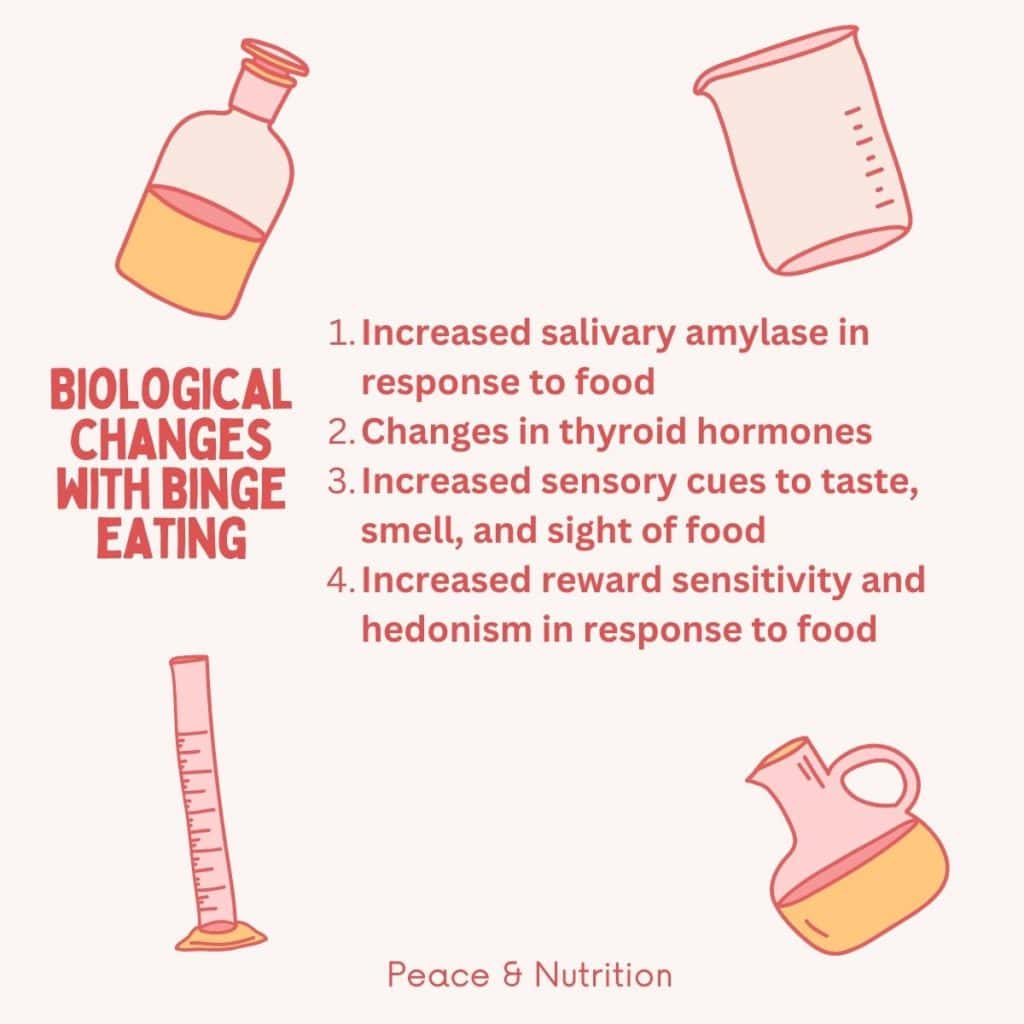
Self Care For Binging and Restricting
Breaking the binge restrict cycle can lead to an emotional roller coaster. The binge restrict cycle can feel overwhelming, but practicing mental self-care is an important step toward breaking free. One of the most powerful tools is self compassion. Instead of criticizing yourself after eating, try reminding yourself that one meal or one binge does not define you, you’re still learning and healing. Emotionally and physically offer yourself grace during this time.
Some things you can do to reduce stress that comes along with bingeing and restricting include:
- Respect your body
- Stop body checking
- Stop counting calories
- Practice joyful movement
- Make a list. of eating disorder recovery quotes or body-positive mantras
- Use body-positive journal prompts to journal your experiences daily
- Keep your favorite body positive mantras top of mind
Remember, breaking the binge restrict cycle takes time. It will involve coping with both binge episodes and resisting the urge to restrict your food. Seeking out support such as trusted friends or professionals that can help you work through difficult emotions will be beneficial.
- Diet Culture is Toxic - December 22, 2025
- I Don’t Eat Anything White - December 11, 2025
- I Wish I Had More Control With Food - November 18, 2025